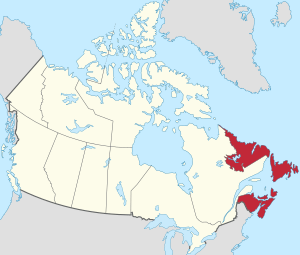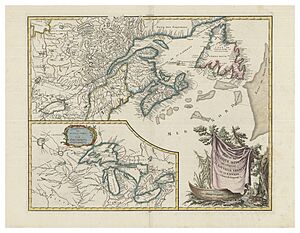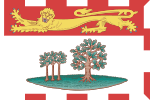Atlantic Canada facts for kids
Quick facts for kids
Atlantic Canada
Provinces de l'Atlantique (French)
|
|
|---|---|

Atlantic Canada (red) within the rest of Canada
|
|
| Country | Canada |
| Composition | |
| Most populous municipality | Halifax |
| Area | |
| • Total | 488,000 km2 (188,000 sq mi) |
| Population
(2021)
|
|
| • Total | 2,409,874 |
| • Density | 4/km2 (10/sq mi) |
Atlantic Canada, also known as the Atlantic provinces, is a special region in Eastern Canada. It includes four provinces that are right on the Atlantic coast. These provinces are New Brunswick, Newfoundland and Labrador, Nova Scotia, and Prince Edward Island.
As of 2021, the land area of these four provinces was about 488,000 square kilometers. More than 2.4 million people lived there. The name Atlantic Canada became popular after Newfoundland joined Canada in 1949.
Contents
History of Atlantic Canada
The Atlantic Provinces are the traditional lands of several Indigenous peoples. These include the Mi'kmaq, Naskapi, Beothuk, and Nunatsiavut peoples. The Nunatsiavut people are the Labrador Inuit. They are descendants of the Thule people.
In 1604, a French colony called Acadia was started in what is now Atlantic Canada. This was led by Samuel de Champlain and Pierre Dugua, Sieur de Mons. The French formed friendships with many Indigenous groups in the area. This included the Mi'kmaq of Acadia. They joined the Wabanaki Confederacy, who were important allies to New France.
The first premier of Newfoundland, Joey Smallwood, created the term "Atlantic Canada." This happened when the Dominion of Newfoundland joined Canada in 1949. He felt it was not right for Newfoundland to call itself a "Maritime province." That term was already used for New Brunswick, Prince Edward Island, and Nova Scotia. These provinces joined Canada earlier. New Brunswick and Nova Scotia joined in 1867. Prince Edward Island joined in 1873.
Geography of the Atlantic Provinces
Quebec has a coast on the Gulf of St. Lawrence. However, it is usually not seen as an Atlantic Province. Instead, Quebec is part of Central Canada, along with Ontario. Atlantic Canada and Central Canada together are known as Eastern Canada.
Atlantic Canada has part of the Appalachian Mountains. This section is called the Appalachian Uplands. In each Atlantic province, these Upland regions are divided into three highland areas. The mountains cause the coastal areas to have fjords. Some places also have deposits left by glaciers.
The tables below use information from Statistics Canada's 2021 census.
Major Cities in Atlantic Canada
This table shows some of the largest cities and towns in Atlantic Canada.
| Municipality | Province | Municipal land area (km2) | Urban (population centre) land area (km2) |
|---|---|---|---|
| Halifax | Nova Scotia | 5,475.57 | 238.29 |
| St. John's | Newfoundland and Labrador | 446.02 | 178 |
| Moncton | New Brunswick | 140.67 | 110.73 |
| Saint John | New Brunswick | 315.59 | 70.05 |
| Fredericton | New Brunswick | 133.93 | 89.60 |
| Cape Breton | Nova Scotia | 2,419.70 | 30.91 |
| Charlottetown | Prince Edward Island | 44.27 | 57.56 |
| Truro | Nova Scotia | 37.52 | 31.52 |
| New Glasgow | Nova Scotia | 9.96 | 29.82 |
| Bathurst | New Brunswick | 91.62 | 27.92 |
| Corner Brook | Newfoundland and Labrador | 147.88 | 21.60 |
| Miramichi | New Brunswick | 178.98 | 27.78 |
| Kentville | Nova Scotia | 17.08 | 27.98 |
| Edmundston | New Brunswick | 106.84 | 19.06 |
| Summerside | Prince Edward Island | 28.21 | 16.97 |
| Grand Falls-Windsor | Newfoundland and Labrador | 54.84 | 12.34 |
Land Area of Each Province
This table shows the land area for each of the Atlantic provinces.
| Province | Land area (km2) |
|---|---|
| New Brunswick | 71,248.50 |
| Newfoundland and Labrador | 358,170.37 |
| Nova Scotia | 52,824.71 |
| Prince Edward Island | 5,681.18 |
People and Population (Demographics)
The tables below show population numbers from the 2021 census. They include "Metropolitan Areas" (which are entire cities and towns) and "Population Centres" (which are just the built-up areas).
Populations of Cities and Towns
This table lists the populations of the main cities and towns in Atlantic Canada.
| Municipality | Province | Type of Municipality | Population of Metropolitan Area | Population of Municipality | Population of Urban Area |
|---|---|---|---|---|---|
| Halifax | Nova Scotia | Municipality | 465,703 | 439,819 | 348,634 |
| St. John's | Newfoundland and Labrador | City | 212,579 | 110,525 | 185,565 |
| Moncton | New Brunswick | City | 157,717 | 79,470 | 119,785 |
| Saint John | New Brunswick | City | 130,613 | 69,895 | 63,447 |
| Fredericton | New Brunswick | City | 108,610 | 63,116 | 64,614 |
| Cape Breton | Nova Scotia | Municipality | 98,318 | 93,694 | 30,960 |
| Charlottetown | Prince Edward Island | City | 78,858 | 38,809 | 52,390 |
| Truro | Nova Scotia | Town | 46,157 | 12,954 | 23,583 |
| New Glasgow | Nova Scotia | Town | 34,397 | 9,471 | 19,316 |
| Bathurst | New Brunswick | City | 31,387 | 12,157 | 15,985 |
| Corner Brook | Newfoundland and Labrador | City | 29,762 | 19,333 | 19,129 |
| Miramichi | New Brunswick | City | 27,593 | 17,692 | 11,594 |
| Kentville | Nova Scotia | Town | 26,929 | 6,630 | 14,905 |
| Edmundston | New Brunswick | City | 22,144 | 16,437 | 13,125 |
| Summerside | Prince Edward Island | City | 18,157 | 16,001 | 14,952 |
| Grand Falls-Windsor | Newfoundland and Labrador | Town | 13,853 | 13,853 | 11,986 |
Population of Each Province
This table shows the total population and how many people live per square kilometer in each Atlantic province.
| Province | Population | Population density (people per km2) |
|---|---|---|
| New Brunswick | 775,610 | 10 |
| Newfoundland and Labrador | 510,550 | 1 |
| Nova Scotia | 969,383 | 18 |
| Prince Edward Island | 154,331 | 27 |
Economy and Resources
The main natural resource industries in Atlantic Canada are fishing, hydroelectricity, forestry, and mining. The Atlantic provinces produce about 75% of Canada's fish. Many towns along the coast rely mostly on fishing. They access fishing areas in the Gulf of St. Lawrence and the Atlantic continental shelf.
Nova Scotia produces 75% of Canada's gypsum. Salt and iron are also mined in the Atlantic provinces.
See also
 In Spanish: Provincias atlánticas de Canadá para niños
In Spanish: Provincias atlánticas de Canadá para niños







